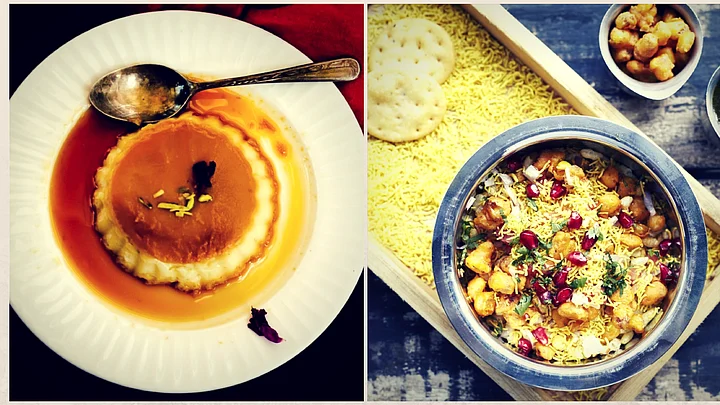The fragrance of filter coffee, the aroma of chicken soup, and the delectable smell of a freshly baked vanilla cake – there is so much memory behind all our comfort food. No wonder the catchphrase ‘Drinks and Memories’ gave an instant connect as it linked your juice packet to a cute childhood tale.
The Armenian-Bengali Fusion
The only recipient of the coveted ‘Best Chef of India’ award by the President of India, Chef Sabysachi Gorai (Saby) launched Lavaash by Saby at Mehrauli, which traces the culinary influence of early Armenian settlers in Calcutta, on the food that we eat today. Saby reveals how the genocide in 1915 left 6 million Armenians dead, as a result of which Armenians became the largest diaspora who came to India, slightly before the Parsis. With his Bombay background, Saby relived one phase of memory with the conceptualisation of the eclectic restaurant SodaBottleOpenerWala while Lavaash by Saby completed his circle of nostalgia.
“Cocktails at Lavaash are inspired by tribal stories, folklore, gang wars and black magic,” says Gorai, whose anthropologist father wrote a coal mining history book that got Saby back in touch with his roots. No wonder Lavaash’s version of whisky sour called ‘LG Shakti’ is inspired by the country liquor of Asansol called ‘Shakti’, while also being a tribute to his father Shakti Gorai, even as he combined it with his dad’s reference to underworld goons as LG or Local Gundas!
A pretty little yellow bird, carried in a cage above head level to judge the levels of methane gas, turned into ‘My yellow canary’ drink, while the noisy sounds of pigs and piglets inspired the ‘Suourer bachcha’ cocktail. ‘Black diamond’ drink is a reference to the first English style train that ran from Calcutta to Asansol, while the fragrant ‘Mahua Mehul’ drink, which uses the fragrant flowers of Eastern India, is dedicated to his sister Mahua!
The Parsi – Irani Flavour
With chalkboard menus, glass jars full of sweet treats, retro style disco music, and amusing posters that warn you not to comb hair or ask for credit, the inspiration at SodaBottleOpenerWala restaurant is witty and irreverent, as much as traditional and old world.
The charming Chef Manager at SodaBottleOpenerWala, Anahita N Dhondy, is one of the 300 odd Parsis, who still live in Delhi-NCR, and who add a touch of the exotic by creating dishes from their memories. “As a child, I grew up with the most amazing aromas in the house, with mom constantly surprising us with her new creations. A soft bun, nicely lathered butter and a nicely spiced omelette with chai would be a satisfying meal after a long day while Eedu (egg) has remained my constant favourite because I love the fact that Parsis put eggs in everything and bake it,” she laughs.
Anahita’s favourite dish continues to be 'Malai par eedu' (coddled eggs), made best by Katy's Kitchen (Kurush and Rhea Dalal) in Bombay, even while she admits that whether it is plated French dishes or Bombay street food, she has the ability bring it together beautifully!
A Journey of Self Discovery
At the launch of Blogger Kalyan Karmakar latest book, which focuses on the disappearing race of Mumbai’s Irani Café’s, both Anahita Dhondy and Kalyan Karmakar regaled the audience with stories of Parsi ‘charm and eccentricity’, even as they shared their joy of discovering old Irani chai places.
Food stories are very appealing to foodies like me who look for that joy of discovery, but the real success of any eatery is an outcome of delicious and consistent food at affordable prices.Kalyan Karmakar, Blogger
Kalyan, whose favourite food memory is of “sharing chops and pakoras in Pramod da's canteen at Kolkata's Presidency College and discovering momos in the Tibetan joints of Kolkata.” He also recalls creating the most amazing East Indian Pork Sorpotel using a Masala gifted by Chef Aloo in Bandra.
Celebrity Chef Kunal Kapur attributes his passion for food to memories of watching his dad cook a delicious Sunday lunch, while he sat on an upturned ‘Dalda’ box and repeated the ingredients diligently.
TV show host Chef Saransh Goila believes these stories are crucial. Goila insists that he doesn’t learn dishes, “Instead, I understand communities and their stories, and that is why I know exactly how “Jammu ke Rajma’ is made and why it tastes so good.”
Clearly, we all love our food stories as much as we love our food, and so, when we get storytelling and nostalgia on the same plate, it is both heavenly and divine.
(A post graduate from the Indian Institute of Mass Communication with an MBA in HR, Meenakshi Sharma conceptualizes and executes literary events, communication and HR projects with the same passion that she exhibits when she writes about people, places, food and relationships!)
